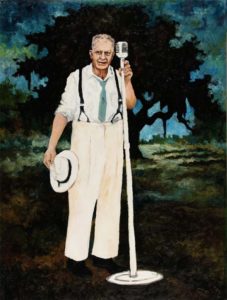George Rodrigue
George Rodrigue, born and raised in New Iberia, is best known for his Blue Dog series of paintings and sculptures.

Courtesy of Haynie Family Collection.
Earl Long, the irascible forty-fifth governor of Louisiana, is depicted giving a speech in this painting by Lafayette artist George Rodrigue.
Internationally renowned for his iconic Blue Dog and signature depictions of Cajun and Louisiana life framed beneath the embrace of live oak trees, George Rodrigue achieved the status of Louisiana’s most recognizable and collected artist.
Early Life and Career
Born and raised in New Iberia, Louisiana, George Rodrigue determined his future in art while sick with polio as a child. His mother brought him a paint-by-numbers set, a 1950s-era invention, to ease his boredom. Eight-year-old Rodrigue used the paints and canvases, however, to paint not the suggested country lanes and replica of The Last Supper, but rather fire trucks, monsters, and alligators. Following a full recovery, he set his course on art and never wavered.
In 1962 Rodrigue enrolled at the University of Southwest Louisiana, now the University of Louisiana at Lafayette, where he studied abstract expressionism. A project for Prof. Calvin Harlan’s design class proved most useful when he applied to art school. His design book secured his acceptance to the prestigious Art Center College of Design (then located in Los Angeles, now in Pasadena), where Rodrigue studied not only the fundamentals of art such as figure drawing, but also graphic design, illustration, automotive design, and photography. Most important, at Art Center Rodrigue studied for the first time with working artists, significantly Lorser Feitelson, the master of hard-edge painting, an abstract style of art defined by impersonal paint application and delineated areas of color with particular sharpness and clarity.
While in California, from 1963 to 1967, Rodrigue also admired pop artist Andy Warhol, who premiered his Campbell’s Soup Cans at the Ferus Gallery in Los Angeles. The literal and figurative distance from South Louisiana also influenced the young artist, who worried that his unique Cajun culture would fade within a modern world of television and travel. Unlike his Art Center classmates, many of whom pursued careers in the art capital of New York City, Rodrigue returned to his native Acadiana region of Louisiana. He used the hard edge and pop influences of California’s emerging art scene of the late 1960s to paint the landscape and people of his home state. Ultimately, Rodrigue graphically interpreted his culture, coining a new phrase, “Cajun Artist.”
International Recognition and Success
In 1974 Rodrigue won an Honorable Mention for his painting The Class of Marie Courrege at the historic Le Salon des Artistes in Paris, prompting a review from the French newspaper Le Figaro, which dubbed him “America’s Rousseau.” In 1976 he wrote The Cajuns of George Rodrigue (Oxmoor House). The National Endowment for the Arts presented the book to First Lady Rosalynn Carter, who chose it as an official gift of state during her husband’s administration.
Rodrigue first painted what would become his most famous image, the Blue Dog, in 1984, imagined for a collection of ghost stories. The book Bayou, by Chris Segura (Inkwell Press), included forty Louisiana tales, including the loup garou, a werewolf or ghost dog said to lurk in cemeteries and sugar cane fields. When he was a boy, Rodrigue’s mother had warned him, “If you’re not good today, the loup garou will eat you tonight!” The artist invented a red-eyed, frightening image loosely based on photographs of his deceased studio dog, Tiffany. He painted the loup garou at night under a blue-moon sky, casting a blue-grey shade on the dog’s fur.
Over the following ten years, the loup garou developed into the iconic Blue Dog, an image that catapulted Rodrigue’s fame worldwide. By 1991 he had galleries in Lafayette, New Orleans, and Carmel, California, a seaside community where he had enjoyed painting during his Art Center years. In 1992 the Wall Street Journal featured Rodrigue and his Blue Dog with an article on its front page, and in 1993 he joined such luminaries as Andy Warhol and Keith Haring in the league of artists selected for an art-based advertising campaign for Absolut vodka that became a pop culture phenomenon.
After donating more than $3 million for humanitarian and arts organizations in the wake of the World Trade Center attacks of September 11, 2001, and Hurricane Katrina in 2005, Rodrigue established the George Rodrigue Foundation of the Arts in 2009. The foundation encourages the use of art within all school curricula and provides funds for scholarships, classroom art supplies, and a variety of art educational programs.
In 2006 the State of Louisiana appointed Rodrigue the state’s official artist laureate and bestowed on him the Lifetime Achievement Arts Award. In 2009 the University of Louisiana at Lafayette presented him with an honorary doctorate of fine arts. In 2011 the Center for Louisiana Studies awarded Rodrigue the James William Rivers Prize, established “to honor persons who have contributed or rendered, recently or over the course of their careers, outstanding scholarly study, work, or teaching about the culture, history … and art of Louisiana or about its people.” In 2011 the National Boy Scouts of America presented the artist with its highest honor, the Distinguished Eagle Award.
In 2011 Rodrigue was diagnosed with lung cancer, which he suspected was caused by exposure to toxins in the varnishes that he applied to his canvases in an unventilated studio. After two years of aggressive treatment and a retreat to his home and studio in Carmel to paint and recuperate, Rodrigue died December 14, 2013.
